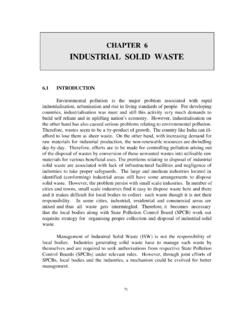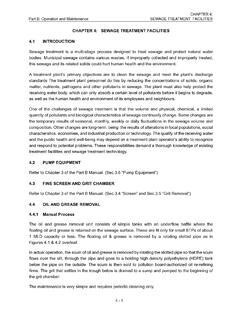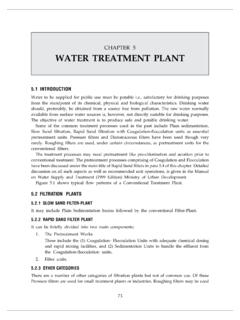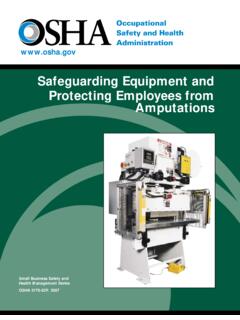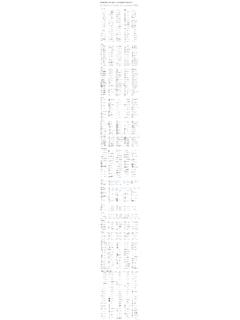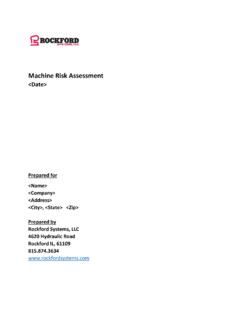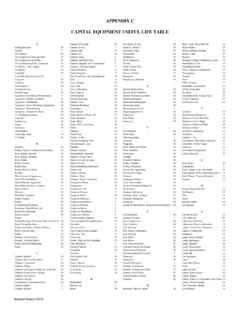Transcription of CHAPTER 6: DESIGN AND CONSTRUCTION OF SLUDGE …
1 Part A: Engineering6 - 1 CHAPTER 6: DESIGN AND CONSTRUCTION OF SLUDGE TREATMENT FACILITIESCHAPTER 6: DESIGN AND CONSTRUCTION OF SLUDGE TREATMENT THE APPROACHIn STP, SLUDGE means the following. Primary SLUDGE When raw sewage is settled in a primary clarifier, the suspended solids settle down by gravity. These are drawn out from the conical floor of the clarifier. This is called primary SLUDGE (PS). It will have mostly organic substances and also inorganic substances. If it is stored, the organic substances will undergo anaerobic reaction as in Figure This will result in production of Methane and Hydrogen Sulphide gases. Secondary SLUDGE When the sewage is aerated in aeration tanks, biological microorganisms grow and multiply. The aerated liquid is called the mixed liquor. It is settled in secondary clarifiers to separate the microorganisms by gravity. These are drawn out from the conical floor of the clarifier.
2 This is called secondary SLUDGE . Return SLUDGE A major portion of the secondary SLUDGE is returned to the aeration tank for seeding the microorganisms. This is called return SLUDGE (RS). Excess SLUDGE A small portion of secondary SLUDGE is wasted. This is equal to secondary SLUDGE minus return SLUDGE . This is called excess SLUDGE (ES) on waste SLUDGE (WS). Chemical SLUDGE When raw sewage or secondary treated sewage is subjected to chemical precipitation, the resulting SLUDGE is called chemical SLUDGE (CS).In treatment units such as MBR, there are two optional arrangements for separating the treated sewage from the aerated mixed liquor. In one type, the filtration membranes are submerged into the mixed liquor and the treated sewage is sucked out as the filtrate. In this case, there is no secondary SLUDGE or return SLUDGE . The mixed liquor itself is separately wasted as excess SLUDGE . In another type of MBR, the membranes are outside the aeration tank and the mixed liquor is filtered into treated sewage and secondary SLUDGE .
3 The primary and excess SLUDGE are to be further treated to produce fully inert matter which will not decay any further. Normally this is achieved by the treatment process in Figure Here the organisms themselves are food source for new organisms till almost all organisms are reduced. This process also produces methane and hydrogen sulphide gases. The hydrogen sulphide is removed and the methane is sent to gas engines to generate electricity. Alternatively, it can also be achieved by the treatment process in Figure , but this will need aeration and hence electrical energy is to be spent. The typical SLUDGE generation values are shown in Table 6-1 overleaf. The illustrative computation of SLUDGE generation values from ASP is in Appendix A: Engineering6 - 2 CHAPTER 6: DESIGN AND CONSTRUCTION OF SLUDGE TREATMENT FACILITIEST able Typical SLUDGE generation valuesThe capacity of each SLUDGE treatment unit is determined by considering the operating hours, SLUDGE moisture content, retention time, etc.
4 , and is based on the solids balance of the entire SLUDGE treatment facility. The solids balance considers the reduction due to gasification, return load from each facility and the increase due to addition of chemicals, etc. This is important for sizing the SLUDGE treatment units. In general, the primary and excess SLUDGE will need a blending tank before further treatment so that the properties are made almost uniform when feeding the units. After this, if the thickened SLUDGE is put through anaerobic digestion as in Figure for producing Methane, it is called anaerobic digester. If it is oxidized as in Figure , it is called aerobic digester. In both cases, the digested SLUDGE will have to be dewatered. There are many types of equipments like centrifuge or filter press or natural solar drying beds for this purpose. The solids concentrations by different treatment processes are listed in Table Solids concentration by treatment process Source: Guideline and Manual for Planning and DESIGN in Japan, JSWA, 2009 An illustrative solids balance in two different types of SLUDGE treatment processes is shown in Figure overleaf.
5 In this figure, a pertains to direct dewatering and incineration and b pertains to the case of digestion, dewatering and incineration. Appendix illustrates the calculations A: Engineering6 - 3 CHAPTER 6: DESIGN AND CONSTRUCTION OF SLUDGE TREATMENT FACILITIESF igure Example of solids balance (Conventional Activated SLUDGE Process)In case of option a (dewatering and incineration) the solids balance occurs as follows. The solids load from the STP to the SLUDGE treatment section is taken as 100. The solids load from the recirculation from the various units is taken as Thus, the solids load entering the SLUDGE treatment units is The solids load escaping in the liquid portion from the blending tank is taken as 10 Thus, the solids load entering the SLUDGE thickener becomes The solids load escaping in the liquid portion from the thickener is taken as The solids load leaving the thickener becomes In the dewatering centrifuge, solids load from polyelectrolyte is Thus solids load entering the dewatering centrifuge is The solids load in the dewatered cake is The solids load of is in the filtrate and is recirculated The solids load of in the dewatered cake is sent to fluidized bed and incinerator Here.
6 The solids load of goes into the formation of combustion gases The solids load of escapes in the liquid portion of the fluidized bed The solids load of remains in the final product as ash. Similarly, in the case of process b, the solids load in the final product becomes instead of in process a. Moreover, a digestion gas equivalent of is gained, which in turn is a source of energy. Part A: Engineering6 - 4 CHAPTER 6: DESIGN AND CONSTRUCTION OF SLUDGE TREATMENT FACILITIESThus, anaerobic digestion has its importance. The solids recovery rate varies at each stage of SLUDGE treatment and is shown in Table Example of solids recovery rate in each treatment stageSource: Guideline and Manual for Planning and DESIGN in Japan, JSWA, HYDRAULICS OF SLUDGE SLUDGE PipingSludge piping can be by gravity or by pumping. For example, when primary SLUDGE is drawn from clarifiers, it is sometimes by gravity and sometimes by direct suction using pumps.
7 The friction loss in gravity pipelines and pumped pipelines are calculated as Friction losses in Gravity SLUDGE Pipelines 1. Calculate friction loss using Manning s formula as though it is flowing with water. 2. This friction loss is multiplied by a friction compounding factor (F) as follows 3. Estimate the solids content in the SLUDGE (P). 4. F for undigested SLUDGE is = + ( P P) ( P) 5. F for digested SLUDGE is = + ( P P) ( P) 6. Allow for an additional factor of safety of 10%. Friction Losses in Pumped SLUDGE PipelinesFirst calculate the head loss as though it is pumping water by using the Hazen Williams formula with the value of C taken from Table overleaf. Then, multiply the head loss by the factor k from Figure for the given solids content (P).Part A: Engineering6 - 5 CHAPTER 6: DESIGN AND CONSTRUCTION OF SLUDGE TREATMENT FACILITIEST able Hazen Williams value of C for SLUDGE flows Source: Metcalf & EddyFigure Head loss Multiplication Factor for Different SLUDGE Types and ConcentrationsThe equations for these curves are simplified as follows where P is the % of SLUDGE for undigested SLUDGE = - + for digested SLUDGE = - + calculations for these friction losses are illustrated in Appendix A SLUDGE Pump Types and ApplicationsThere are specific considerations to be borne in mind in the use of different types of pumps for handling SLUDGE .
8 The relative applicability of these is shown in Table The illustrations of the internal arrangements of these are compiled in Figure (overleaf) a to d and indexed to serial numbers in Table for an easier visual understanding of these. In respect of impellers in centrifugal pumpsets, the rotary speed is advised not to exceed 960 rpm especially when pumping return SLUDGE . Part A: Engineering CHAPTER 6: DESIGN AND CONSTRUCTION OF SLUDGE TREATMENT FACILITIES6 - 6 Table Types of SLUDGE pumps and their applicationPart A: Engineering6 - 7 CHAPTER 6: DESIGN AND CONSTRUCTION OF SLUDGE TREATMENT FACILITIESF igure a Types of SLUDGE pumpsPart A: Engineering6 - 8 CHAPTER 6: DESIGN AND CONSTRUCTION OF SLUDGE TREATMENT FACILITIESF igure b Types of SLUDGE pumps-continuedPart A: Engineering6 - 9 CHAPTER 6: DESIGN AND CONSTRUCTION OF SLUDGE TREATMENT FACILITIESF igure c Types of SLUDGE pumps-continuedPart A: Engineering6 - 10 CHAPTER 6: DESIGN AND CONSTRUCTION OF SLUDGE TREATMENT FACILITIESF igure d Types of SLUDGE Centrifugal PumpsCentrifugal pumps (as in notation 3 in Table and Figure a) for handling SLUDGE must be of the non-clog type.
9 They should be robust and should have easily accessible hand-holes for cleaning. Pumps of the macerator type impeller or additional cutters with a cutting ring whereby stringy rags and other fibrous material can get shredded are preferable. When the specific speed of the pump is low, non-clog impellers are designed with less number of blades than in impellers for handling clear liquids. In pumps of high specific speed, the mixed flow impeller should generally have wide passages. Centrifugal pumps with non-clog impellers have less efficiency than those of normal DESIGN for handling clear liquids. The rating for the drive motor has to be selected keeping this in mind. The specific speed of the pump also affects the suction-lift capability of the pump. This can be overcome by selecting a vertical centrifugal pump to be so installed that the impeller would be adequately submerged always.
10 The impellers are best chosen as open impellers or semi open impellers or centrifugal screw A: Engineering6 - 11 CHAPTER 6: DESIGN AND CONSTRUCTION OF SLUDGE TREATMENT Air-Lift PumpsAir lift pumps (as in notation 1 in Table and Figure d). These are used in small extended aeration plants to return the SLUDGE and scum to the aeration tank. Small air bubbles are formed in the liquid, which makes the air-water mixing less dense to get lifted to the discharge compressor / blower supplies the air. Air-lift pumps and ejectors are pumping systems, which are though inherently inefficient, there are no moving parts inside and hence, their operation is fairly trouble-free. screw PumpsThese are three major variations of these as under 1. Archimedean screw (as in notation 2 in Table and Figure c) 2. Stator-Rotor or Progressive Cavity (as in notation 6 in Table and Figure a) 3. Centrifugal screw Impeller (as in notation 10 in Table and Figure c)In the Archimedean screw pumps, the SLUDGE enters the screw pump by a screw conveyor , which moves solids to an open impeller and lifts them to the point of discharge.



